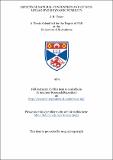Aspects of natural convention and of non-linear hydridynamic stability
Abstract
In Part I of this thesis, steady and time-dependent, natural-convection similarity flows with mass transfer are discussed. Similarity flows for natural convection on families of two-dimensional bodies with closed lower ends are enumerated, when both a temperature distribution and a suction velocity distribution are prescribed at the body surface. For steady similarity flow on a heated vertical flat plate, with mass transfer at the surface, a numerical procedure is introduced for determining the velocity and temperature profiles. These results are presented in Figs. 2 and 3. Other similarity flows may be found by the same method.
A simplification, valid for “strong” suction, is discussed. An extension of Mangler’s transformation [1948] is given which reduces the equations governing axisymmetric flow to those for two-dimensional flow in steady natural convection.
In Part II non-linear resonant instability in parallel shear flows is discussed. A.D.D.Craik’s (see Usher and Craik [I]) modified version of Bateman’s [1956] variational formulation for viscous flows is employed to derive the second-order interaction equations governing the temporal evolution of a resonant wave triad in a sheer flow. (An extension of Craik’s variational formulation to free surface flows is presented but is not required in the subsequent analysis for the resonance problem). This problem was treated previously using a ‘direct’ approach (employing the Navier-Stokes equations) by Craik [1971]. The major advantage of the present method over the ‘direct’ method is the substantial reduction in algebraic complexity. Also, a justification of the validity of Craik’s previous analysis is given.
For this same resonance problem, third-order interaction equations are derived by the *direct* method since, to this order of approximation, little advantage is to be gained from the variational formulation. The resonance theory is thereby developed to the same order of approximation as the non-resonant third-order theory of Stuart [1960, 1962].
An asymptotic analysis for large Reynolds numbers reveals that the magnitudes of the third-order interaction coefficients – like certain of those at second-order – are remarkably large. Such results lead to a discussion of the regions of validity of the perturbation analysis. Also some light is shed on the roles played by resonance and three-dimensionality in the non-linear instability of shear flows.
Type
Thesis, PhD Doctor of Philosophy
Collections
Items in the St Andrews Research Repository are protected by copyright, with all rights reserved, unless otherwise indicated.

